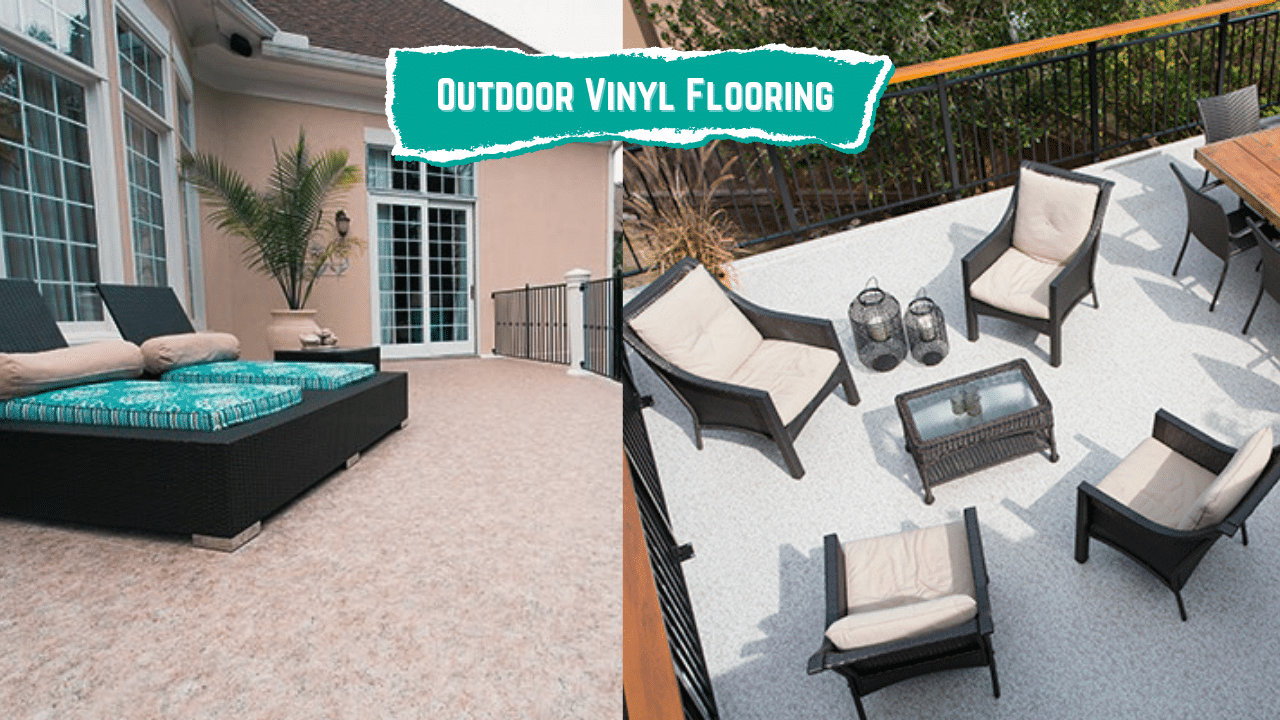At this point, I bet you’ve probably heard about the numerous benefits of vinyl plank flooring. For starters, this flooring material is more durable, easier to clean, and visually appealing…. The list could go on.
It’s only natural for some homeowners to want them installed in every corner of their home, including the outdoor patio. (Related: EVP Flooring For Your Home: Pros, Cons & Costs)
Now, is vinyl an excellent option for outdoor flooring use? Let’s take a closer look at the factors, as well as other alternatives you can consider instead of vinyl.
Key Considerations Before Using Vinyl Flooring Outdoors

1. Vinyl Floors can be Used Outdoors
Technically, it’s possible to install vinyl floors on your outdoor patio as it is durable, moisture-resistant, and requires little maintenance.
An outdoor patio with vinyl flooring makes for a comfortable and highly durable living space. Use vinyl floors in an outdoor, temperature-controlled environment– such as a sunroom or enclosed porch.
2. It is Not Often Recommended
Professionals do not recommend installing vinyl floors in outdoor areas. Instead, floor coverings are considerably more ideal to use.
Vinyl may be 100% waterproof, but temperature fluctuations may affect the floor’s condition. Let’s say the vinyl floors are frequently exposed to cold temperatures, rainfall, or sunlight exposure– it may crack or swell like laminate flooring.
Thanks to plenty of advancements in the industry, some vinyl floor coverings have been approved for outdoor installation. However, professionals may still advise you to look for other alternatives that are far more suitable.
3. It is Very Durable for Outdoor Use
Installing vinyl on the patio or porch means you’ll have durable floors. If you have kids or pets at home, they can use the area as their play place without having to worry about any scratches or damage.
This flooring type has plenty of traction to decrease the likelihood of accidents or injuries.
4. It Doesn’t Need Fastening
Another benefit to keep in mind is that vinyl flooring doesn’t require fastening to the subfloors. You won’t need to secure it using nails or screws– effectively decreasing the chances of injury or accidents.
5. You have Plenty of Choices
Vinyl flooring for outdoor use can be a flexible choice. For one, vinyl floor mats and rolls are readily available in different colors and designs.
If you want to mimic a particular indoor flooring design on your outdoor patio, vinyl flooring planks are there to your rescue.
6. Vinyl Floors may React to Heat
Once there are changes in the temperature, vinyl flooring material may expand (extreme heat) or tighten (cold). Hence, the interplay may leave permanent damage to your outdoor floors.
7. Vinyl Flooring Cannot Withstand Cold Temperatures
Unfortunately, vinyl floors are prone to damage in freezing temperatures. If you live in an area with extremely harsh winters, outdoor vinyl flooring may not be the best option. You’ll only be signing up for frequent cracks in the floor and planks being out of place.
Meanwhile, moderately cold regions may enjoy the benefits of vinyl floors for outdoor use. Vinyl is known to be an excellent heat insulator, giving you a comfortable underfoot even in the cold.
8. You Have Other Flooring Alternatives to Consider
If you’re looking for excellent flooring alternatives instead of vinyl floorings for outdoor use, we got you covered.
9. The Benefits of Vinyl Outdoor Floors
10. The Drawbacks of Vinyl Outdoor Floors
11. Avoid Installing the Outdoor Vinyl in Areas with Direct Sunlight Exposure
Unless the manufacturer tells you it’s okay to put your new vinyl floors in areas with direct sunlight – it’s best not to.
In particular, vinyl material with a lower quality wear layer may break down in the long run if exposed to constant sunlight. There’s no need to worry, though. Plenty of outdoor vinyl materials in the market do not have this problem, but it’s best to check first.
12. You Will Need to Ensure a Good Foundation
You can’t install outdoor vinyl floors on the dirt. To ensure a successful installation project, have a good foundation that adequately supports the floors.
Most foundations and subfloors are made of concrete or wood. If you have any of these at home, these will do. Ideally, these subfloors have been previously treated for moisture resistance (or at least covered with a moisture barrier).
Frequently Asked Questions (FAQs)
What temperature can vinyl flooring withstand?
Typically, vinyl flooring can withstand between 65 and 85 degrees. Temperature above or below this level can lead to thermal expansion and contraction on the flooring. Extreme temperature does not go well with vinyl flooring. It will expand when exposed to too much hot temperature and contracts on cold temperatures. If you allow any of these to happen, it may cause your company warranty to be voided.
How long does outdoor vinyl last?
When installed correctly, an outdoor vinyl flooring will usually last for 10 to 20 years. However, life span still depends on the quality, brand, and texture. You may opt for the thicker vinyl types for those who prefer long-term projects, as they usually last for roughly about 25 years. Although, if you are low on budget and choose thin vinyl, you will benefit from attractive flooring for 5 to 10 years. Beyond that, it will begin to lose its color and may swell or crack.
